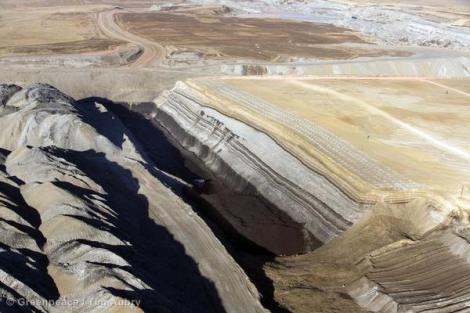Update Aug 23: In a stunning development, there wasn’t a single bid at the BLM auction, with Cloud Peak Energy passing up the chance to bid out of fear that it would not be profitable.
Tomorrow, the Bureau of Land Management will sell off roughly 148 million tons of coal. The BLM is opening the sealed bids for the so-called “Maysdorf II” tract in the heart of the Powder River Basin in Wyoming. The coal will likely be sold to Cloud Peak Energy, which operates the adjacent Cordero Rojo mine, one of the nation’s largest strip mine operations.
Cloud Peak Energy’s Tesoro Rojo mine, soon to be expanded. Video by Greenpeace.
According to Joe Smyth of Greenpeace, who penned a great post putting this sale (and another, even larger coal lease scheduled for next month) in the context of President Obama’s recent climate announcements, the coal will be sold for roughly $1-per-ton. That represents a deep discount below market rates, which is what you’d expect from a lease auction with only one bidder.
The environmental groups aren’t the only ones raising the red flags about this controversial auction process. The Interior Department’s own Inspector General issued a report earlier this summer that criticized the agency for failing to consider the exports of Powder River Basin coal, and that Americans were losing hundreds of millions of dollars in these closed-bid (frequently single-bidder) auctions.
The Institute for Energy Economics and Financial Analysis (IEEFA) carried the numbers out further, finding that Americans have been shortchanged nearly $30 billion for all of the existing leases in the Powder River Basin over the past three decades, because the BLM failed to set a fair value for the price of the coal to be mined. (It should be noted that the calculation of “fair market value” by the BLM is notoriously arcane and complicated. That IEEFA report does some incredible work explaining it. You can dig in for yourself if you’d like. Jump ahead to page 26.)
Seeing as the bidding will be opened tomorrow, let’s piggy-back on Smyth’s post and crunch some more numbers about this particular lease.
Maysdorf II, by the numbers
- 1,338 acres: Size of the “Maysdorf II” coal tract to be leased
- 148,565,000 tons: Mineable coal in the “Maysdorf II” tract
- $163 million: Potential revenue generated by the lease (estimating price from last auction in the region)
- $1.5 billion: Value of mined “Maysdorf II” coal on the open market
- 241 million metric tons: Carbon dioxide to be released by mined coal*
- 50 million cars: Equivalent emissions of “Maysdorf II” coal in American passenger car annual emissions
- 12.6 days: How long it would take China to burn through all of the “Maysdorf II” coal.
[*My calculations assume that Powder River Basin coal generates 8,500 BTUs per pound, and that 1 million BTUs produces 212.7 pounds of CO2. If anyone knows of a more precise way to calculate these emissions, please let me know in the comments.]
So, let’s recap: 1,338 acres of publicly-owned land in Campbell County, Wyoming will be forever destroyed by strip mining. The federal government (and American taxpayers) get shortchanged by hundreds of millions of dollars. The coal will eventually release the emissions of 50 million American cars driving for a year. And if this coal were to find its way to China, as more and more Powder River Basin coal is, it would be burned up in less than a fortnight.
Sounds like a good deal for Cloud Peak Energy.
Also standing to benefit is BNSF Railway, which will transport the coal out of the region, much of it to export terminals in the Pacific Northwest, assuming one is ever built, which is an open question.
But it’s a bad deal for the federal government, for the American people, and it’s a terrible deal for the atmosphere and children’s lungs everywhere that coal is burned or discarded as coal ash.
Finally, before you go, check out this other Greenpeace video that juxtaposes President Obama’s recent speech on climate with these leases:
Subscribe to our newsletter
Stay up to date with DeSmog news and alerts






